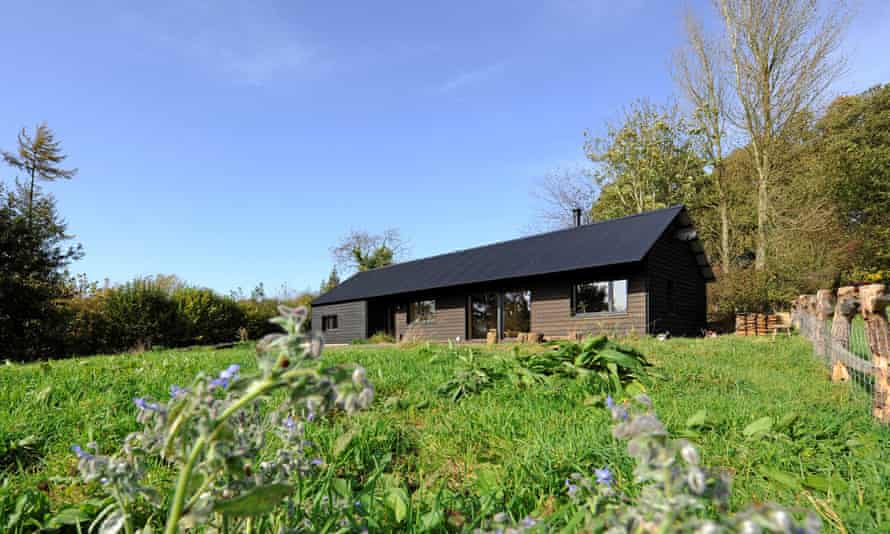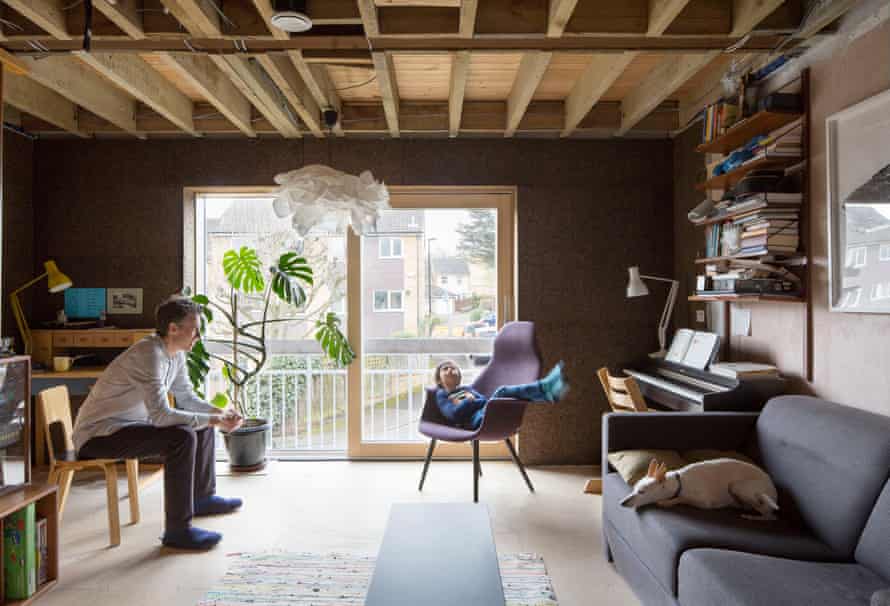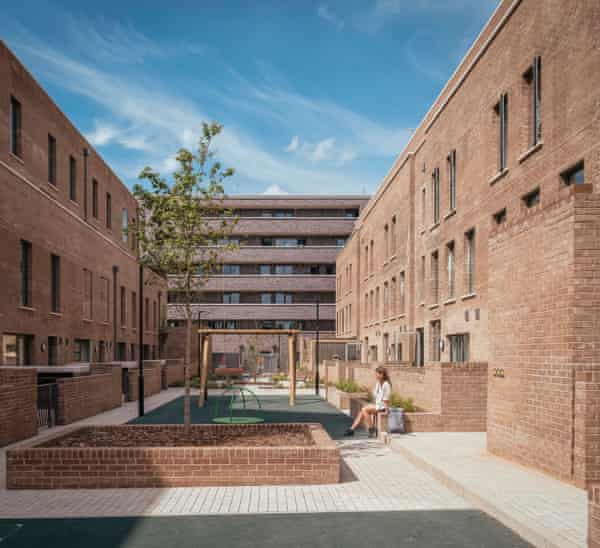Soaring gas prices have been making headlines but for some households heating bills are nowhere near reaching record highs.
These are the residents of Passivhaus homes. There are 1,500 Passivhaus buildings in the UK – and they have never been more popular. Each one is built – or retrofitted – to an internationally recognised “energy and comfort standard”, which typically involves very high levels of insulation, triple-glazed windows and an airtight, draught-free structure.
“It’s a way of ensuring that your building or home is very energy efficient, by reducing the energy demand – particularly for heating – down to very low levels while, at the same time, making sure the building is comfortable inside and has high levels of good indoor air quality,” says Jon Bootland, the chief executive of the Passivhaus Trust. The trust is a non-profit organisation that supervises the awarding of the Passivhaus standard in the UK.
Bootland says over the past 18 months the number of Passivhaus projects in the pipeline has soared. “At the last count, there were over 7,000 homes in development – some only at the planning stage, others in construction and nearly complete.” Membership of the trust has also doubled, from around 250 members in August 2020 to 500 today, suggesting there are now twice as many companies providing specialist design and construction services.
The owners receive a certificate and a plaque, which they can incorporate into the building
To qualify as a Passivhaus in the UK, a building must meet the standards required by the trust and undergo a strict compliance process with an expert consultant who is an accredited certifier. “The certifier supervises the process from the beginning,” Bootland says. “They check the drawings, they check what’s built on site and they check the end result – and then that gets certified, at that point.” It is much more rigorous than the typical building regulations inspections that always occur during the construction of a house, he says.
The owners receive a certificate and a plaque, which they can incorporate into the building.
Although there are no official statistics, Bootland says that based on anecdotal evidence, he would expect a Passivhaus to sell for between 5% and 10% more than a similar property built to normal energy efficiency standards.
Because of the desirability of these homes, Bootland warns anyone looking to buy a Passivhaus to be wary of unclear marketing claims. “A lot of people will say a house has ‘Passivhaus principles’, which actually has no meaning really.” A true Passivhaus will always have a certificate to prove its status and your solicitor should be sent the paperwork during the conveyancing process.
Social housing
Interest in Passivhaus buildings exploded, Bootland says, when local authorities started declaring climate emergencies and setting targets to become carbon neutral – or net zero – in their activities. “If you’re trying to deliver net zero, new-build social housing, one of the best ways to do that is to build a Passivhaus and then have some renewable energy provision locally, possibly on the site.”
If the energy demand of a home is small, then you only need to invest in a small amount of renewables in order to balance that usage out.
There are 1,500 Passivhaus buildings in the UK. Photograph: Jim Stephenson Architectural Photography & Films
Last year, Camden council in London won an award for its Agar Grove development. Consisting of 216 council homes it is the largest Passivhaus scheme in the country and the council says residents have seen a reduction in their energy bills of up to 70% over their old homes.
Flora Irani, 60, recently moved into one of the council homes with her husband and three children. “I love it,” she says. “It is a two-storey, four-bedroom house but we have just two radiators – one downstairs and one upstairs. And we never feel cold. It is amazing.”
She has been a social-housing tenant for 15 years and used to pay £100 a week for gas and electricity but never felt warm enough. Now, she doesn’t pay anything for gas, as heating and hot water are incorporated into her rent, and pays £70 a month for her electricity. “My rent has gone up a little bit – not much – but it’s worth it,” she says.
Unfortunately, inflation and the increased cost of living means spending the money she has saved on her energy bills now goes on essentials such as food. “It’s very helpful but it’s not money for saving or doing something fun with because everything else is more expensive.”
Self-building
As awareness of the climate emergency has grown, Passivhaus designs have become more popular with self-builders.
Juraj Mikurcik built Old Holloway cottage, a three-bedroom, single-storey property in rural Herefordshire, for £135,000 in 2017 – and hasn’t had to pay a gas bill since. “We don’t have any central heating, just two towel rails in the bathrooms and a wood burning stove,” he says. Yet even in the depths of winter, his home always feels perfectly comfortable, he says. “It’s this fairly constant temperature. It doesn’t matter if it’s winter or summer, it’s very even.”
We used to spend £1,500 a year on heating oil just to keep barely comfortable, and another £500 on electricityJuraj Mikurcik
He uses electricity and an air source heat pump to heat his water. In total, his electricity bills come to £65 a month and he gathers firewood to heat his stove. But he rarely needs to light it – only nine times so far this winter. “Even during the ‘beast from the east’, when we had a foot of snow on the roof, we only put the wood burner on for maybe a couple of hours a day. And we were fine,” he says.
It is a far cry from the winters he and his wife used to experience in their previous home, an old stone cottage. “We used to spend £1,500 a year on heating oil just to keep barely comfortable, and another £500 on electricity,” he says.
As an architect, who works for Architype, a firm that specialises in sustainable architecture, he had always dreamed of building his own Passivhaus but had only £50,000 in savings.
 Old Holloway cottage was built for £135,000 in Herefordshire in 2017. Photograph: Kirsty Maguire Architects.
Old Holloway cottage was built for £135,000 in Herefordshire in 2017. Photograph: Kirsty Maguire Architects.
He and his wife bought a plot of land with planning permission for £100,000, putting down a £20,000 deposit and borrowing £80,000 from Ecology building society. They used the remaining £30,000 of their savings to start the build and took out a self-build mortgage – again from Ecology – to fund the rest of the construction costs. The society currently offers builders of Passivhaus homes a discount of 1.25% off its standard rate.
In total, the build cost £135,000 but Mikurcik thinks he saved at least £50,000 by managing the project and doing some of the work himself. The 100 sq metres property is now estimated to be worth just under £400,000.
“We’ve got used to high levels of comfort, so going away on holidays or staying with friends at certain times of year can be a bit of a shock to the system,” Mikurcik says. “It can be quite surprising to go into a normal house and feel cold spots and draughts.”
These homes are typically about 4% to 8% more expensive to build than a normal home, according to the Passivhaus Trust. This is partly because of the stringent quality assurance process builders must undergo, and partly because you are likely to spend more on insulation, ventilation and glazing.
 Old Holloway cottage is a three-bedroom, single-storey property. Photograph: Juraj Mikurcik
Old Holloway cottage is a three-bedroom, single-storey property. Photograph: Juraj Mikurcik
A Passivhaus is also likely to be more time-consuming and difficult to build than a normal home – but “only a tiny bit more”, Bootland says. “The building materials aren’t any more difficult, they can be the same as for other buildings. It’s the attention to detail, in terms of getting the design right, and the fact that the quality control on site is more rigorous.”
He recommends using builders and architects who are on their fourth or fifth Passivhaus project. “They’ve already been through the learning curve and worked out what works and what doesn’t.”
Retrofitting
With the right budget, it is possible to turn an existing property into a Passivhaus via a process known as retrofitting.
Harry Paticas, an architect for Arboreal Architecture and the founder of Retrofit Action For Tomorrow, is currently retrofitting his 1978 mid-terrace home in London. So far, he has spent about £100,000 and cut his energy bills from £1,500 to £600 a year. “The most noticeable impacts were the loft insulation and windows. That is because they were installed in one go, so we could feel the immediate impact before and after,” he says.
He estimates that he has added at least £100,000 of value to the property. This is partly because he has converted a garage, which has had the added benefit of making his home more thermally efficient while increasing the size of his living space. The house is also much quieter inside, thanks to the triple-glazed windows, and the roof is now watertight. “It’s so much warmer in the winter and so much cooler in the summer. And that, I think, is really worth a lot,” he says.
 You can turn an existing property into a Passivhaus by retrofitting. Photograph: Agnese Sanvito
You can turn an existing property into a Passivhaus by retrofitting. Photograph: Agnese Sanvito
Anyone thinking of retrofitting their existing home should ask a Passivhaus consultant to go through their property and develop a staged plan with them before they undertake any work. This consultation can range in cost from a few hundred pounds to a few thousand pounds, depending on where you live in the country and who you hire, but it is particularly important if you live in a period property, a listed home or a conservation area.
“If you’re living in a period property, I would highly recommend getting a very experienced person to help you because of the potential risks,” Bootland says. “In some cases, going to the full Passivhaus retrofit standard might not be the best answer because of the amount of work needed and the effects on the fabric of the building or restrictions such as conservation area rules.”
 Passivhaus buildings are built or retrofitted to an internationally recognised ‘energy and comfort standard’. Photograph: Passivhaustrust.org
Passivhaus buildings are built or retrofitted to an internationally recognised ‘energy and comfort standard’. Photograph: Passivhaustrust.org
In Victorian terraces, for example, walls are breathable and absorb moisture. “If you put insulation on them in the wrong place, or use the wrong kind of insulation, then you can trap the moisture and it can damage the fabric of the building, particularly if you’ve got timber joists,” he says. You may still be able to improve the insulation, “but it might not be financially viable or appropriate to take a building like that to the full Passivhaus retrofit standard. So definitely get expert advice. Don’t try to do it yourself.”
Mortgages
If you are buying or building a Passivhaus, you may be able to fund it with a green mortgage. These mortgages reward you for owning an energy efficient home, typically by offering you discounts or cashback.
Ecology building society, for example, offers owners of these homes a discount of up to 1.25% off its standard rate, and will lend on retrofit costs or for self-build, or to help you buy a new Passivhaus. The discounted rates on offer range from 2.4% to 2.9%, depending on what you are buying and whether you are renovating or building the property.
Nationwide building society offers up to £500 cashback to borrowers buying an energy efficient home, while Halifax offers £250. You can also get up to £500 cashback from Halifax or Lloyds Bank when you make one of several eligible “green living” improvements to your home, such as insulating it or installing triple-glazed windows. If you install a ground or air source heat pump, you may qualify for up to £1,000 cashback.
[ad_2]
Originally Appeared Here